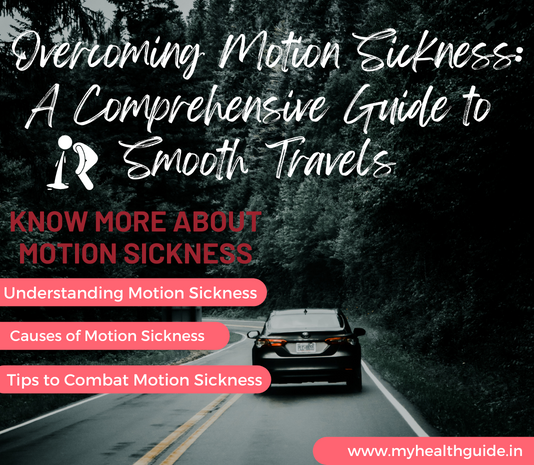Have you ever looked forward to a road trip, cruise, or even a simple ride in the backseat, only to find yourself feeling nauseous and dizzy?
Motion sickness can turn a joyful journey into a miserable experience, but fear not! In this guide, we’ll explore the ins and outs of motion sickness, its causes, and most importantly, how to overcome it, ensuring your future travels are smooth and enjoyable.
Motion sickness is a common condition that occurs when there is a discrepancy between what your eyes perceive and what your inner ear senses.
This sensory dissonance can trigger feelings of nausea, dizziness, and discomfort. It can affect anyone, regardless of age or travel experience, and often catches us off guard.
When your eyes see one thing (like the interior of a moving vehicle), but your body feels another (motion), it can lead to motion sickness.
The inner ear plays a crucial role in balance, and when it receives conflicting signals from your eyes, it can result in nausea.
Reading, playing video games, or engaging in activities that demand intense focus can exacerbate nauseousness.
Opt for a seat where you have a clear view of the horizon. This helps synchronize what your eyes see with your body’s sense of motion.
Keep the vehicle well-ventilated or step outside for a breath of fresh air if you’re on a boat or plane.
Dehydration can worsen motion sickness, so drink plenty of water before and during your journey.
Ginger has natural anti-nausea properties. Consider ginger candies, ginger ale, or supplements to alleviate symptoms.
Break up your journey with short breaks to stretch your legs and reset your senses.
Avoid heavy or greasy meals before traveling, and opt for light, easily digestible snacks.
Acupressure wristbands can help alleviate nausea by applying pressure to specific points on your wrists.
Listen to soothing music or podcasts and focus on the horizon to divert your attention from motion discomfort.
Understanding that nauseousness is a common and manageable issue can help alleviate the fear associated with it. Embrace the challenge, apply these tips, and gradually build your tolerance to motion.
Picture yourself in a serene and stable environment. Visualization can help your mind override the conflicting signals and reduce feelings of nausea.
Gradually expose yourself to motion stimuli to desensitize your body. Start with short trips and gradually extend the duration as your tolerance improves.
Certain scents, such as peppermint or lavender, are known to have calming effects. Consider using essential oils or scented wipes to create a pleasant atmosphere during your travels.
If possible, choose daytime travel when visibility is better. Our eyes rely on visual cues, and having ample natural light can enhance the synchronization between vision and motion perception.
Ensure a comfortable temperature in your surroundings. Motion sickness symptoms can intensify when you’re feeling too warm.
Anxiety can exacerbate nauseousness. Practice mindfulness and stay positive. Remind yourself that the discomfort is temporary, and focus on the exciting destination awaiting you.
In addition to water, consider hydrating with beverages containing electrolytes to maintain balance in your body.
If motion sickness continues to be a significant hurdle, consider consulting with specialists such as physical therapists or occupational therapists. They can provide personalized advice and exercises to address your specific challenges.
Explore mind-body practices such as yoga or tai chi to enhance your overall sense of balance. These disciplines not only improve physical coordination but also foster a stronger mind-body connection, which can be beneficial in managing motion sickness.
Create a personalized motion sickness survival kit. Pack essentials like ginger supplements, anti-nausea wristbands, a comfortable neck pillow, and any other items that have proven effective for you. Having these items readily available can provide a sense of security during your travels.
Share your experiences and strategies with travel companions. They can offer support, keep an eye out for early signs of motion sickness, and assist with any necessary adjustments, such as finding an optimal seating arrangement.
If certain modes of transportation consistently trigger motion sickness, explore alternative options. For example, if sea travel induces discomfort, consider a scenic train journey or a road trip to your destination.
Keep a travel journal documenting your experiences, triggers, and the effectiveness of different strategies. This not only serves as a useful tool for personal reflection but also provides valuable insights that can guide future travel preparations.
If your motion sickness significantly impacts your life, seeking guidance from healthcare professionals, such as ear, nose, and throat specialists, can help identify potential underlying issues contributing to your susceptibility. They can offer tailored advice and interventions.
Engaging in virtual reality (VR) experiences during travel can be a game-changer for some individuals. VR can immerse you in a different visual environment, reducing the sensory conflict that leads to motion sickness.
Connect with others who experience motion sickness. Online forums and support groups provide a platform to share tips, success stories, and challenges. The sense of community can be empowering and offer new perspectives on managing motion discomfort.
By continuously fine-tuning your approach, you’ll transform motion sickness from a hindrance into a manageable aspect of your travel adventures. Safe and enjoyable travels await you!


I truly appreciate your technique of writing a blog. I added it to my bookmark site list and will
Pingback: The Life-Changing Power of Vaccinations: #1 Comprehensive Guide - MyHealthGuide.in